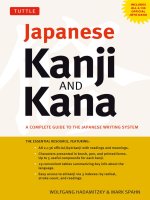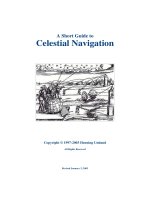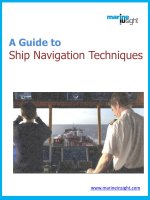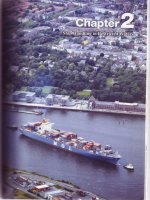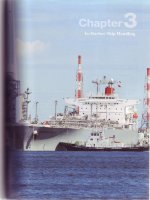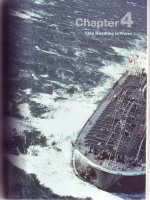A guide to ship navigation techniques
Bạn đang xem bản rút gọn của tài liệu. Xem và tải ngay bản đầy đủ của tài liệu tại đây (2.07 MB, 39 trang )
A Guide to
Ship Navigation Techniques
www.marineinsight.com
Marine Insight©
A Guide to Ship Navigation Techniques
Publication date August 2012.
Author: Karan Chopra
Published by: Marine Insight
www.marineinsight.com
Graphic Design: Anish Wankhede
(copyright symbol) Copyright 2012 Marine Insight
NOTICE OF RIGHTS
All rights reserved. No part of this book may be rewritten,
reproduced, stored in a retrieval system, transmitted or distributed
in any form or means, without prior written permission of the
publisher.
NOTICE OF LIABILITY
The authors and editors have made every effort possible to ensure
the accuracy of the information provided in the book. Neither the
authors and Marine Insight, nor editors or distributors, will be held
liable for any damages caused either directly or indirectly by the
instructions contained in this book, or the equipment, tools, or
methods described herein.
www.marineinsight.com
AUTHOR PAGE:
About the Author
Karan Chopra
Karan Chopra is an experienced Mariner and a Dual
Certificate Holder (Engine and Deck). He has sailed as 2nd
Officer for more than seven years on almost all major
types of vessels. He staunchly believes in spreading
knowledge and therefore loves teaching. In his spare time,
he likes writing about his experiences of the sea and
connecting with new people.
TABLE OF CONTENTS:
Navigation with Wind
……….….…4
Navigation with Current ……………..9
Stopping Distance
……….…....15
Use of Thrusters
……….…….21
Tug Assistance
……….…….29
Berthing Without Tugs ……….…….34
Berthing With Anchors ……….…….37
www.marineinsight.com
CHAPTER 1:
Navigation With Wind
A navigation or deck officer has to be extremely careful
while steering a vessel from its course no matter where the
ship is – at mid sea, crossing channel, or entering/ leaving a
port.
The team at the bridge should be efficient enough to sail
the ship in all kinds of waters and weather. One of the
natural factors about which every navigator should be very
careful while steering a ship is – the wind. Vessels such as
containers and Ro-Ro ships have large freeboard and are
thus more affected by winds.
// Page 4
A Guide to Ship Navigation Techniques
This exposed area of the ship is
also known as the windage area
for the effect of wind is more
prominent. The wind effect on the
same ship will be different at
different places, depending upon
the draught condition of the ship.
A wind with force of 3-4 on the
Beaufort scale will have similar
effect in light condition as with
wind force of 7-8 when the ship is
down to her marks.
When ship is at slow speeds
during manoeuvring or near to
the coast, wind direction is
easy to find; but this is not the
case when out at high seas.
The direction of the wind
perceived when standing on
deck is its relative direction.
This is the resultant of the true
direction of the wind and the
course steered by the ship.
// Page 5
A Guide to Ship Navigation Techniques
It is very important for the ship’s navigator to steer the
ship considering the wind effects so that the ship can be
steered efficiently without any difficulty. Following are
the techniques a navigator must master to control a ship
under wind effects.
Ship underway with wind from right astern
When the wind is blowing from the right astern, steering
the ship becomes easy; however, in case of head wind,
the stern part of the ship has the tendency to pay off on
either sides. This is a difficult situation to tackle and
getting the ship back on course is no piece of cake.
Such effect is more often seen on ships where the
accommodation area is at the aft region. Moreover, the
wind in such case has no braking effect.
Note: Given a choice between head wind & wind from
right astern, the head wind is preferred for berthing.
// Page 6
A Guide to Ship Navigation Techniques
Ship underway with wind from abeam
When the ship is underway with the wind flowing from
abeam, the steering of the ship is not affected. However,
depending on the strength of the wind, the ship drifts
sideways due to leeway and this has to be accounted for
while handling the ship.
Ship underway with wind on the bow
Here again in lighter conditions, the effect on the ship’s
stem is larger and this tends the ship’s head to swing away
from the wind (leeward). This requires the weather helm
(helm on the side of the wind) to be steered continuously.
Ship underway with wind on quarter
When the wind is pushing the ship’s stern away to leeward,
the stern tends to swing towards the leeward. The ship is
therefore steered towards the wind and the ship is required
to be given a lee helm.
// Page 7
A Guide to Ship Navigation Techniques
Vessel under sternway
When the ship is going astern, it
rarely goes at a great speed. When
going astern most ships also tend to
swing to the starboard. The effect of
the wind is therefore a little more
complex.
In ballast condition where the wind
catches the bow, which it often does,
the stern is pulled into the wind. This
effect is quite definite & rapid.
All ships turn around a pivoting point.
This point is an imaginary reference
and is fixed from observations of the
ship turning around. It is known that
when going astern the pivoting point
moves aft.
Effects of wind can be used -
As a
BRAKE
Manoeuvre
// Page 8
For
Tight
Turn
“This effect
must be
remembered
while
manoeuvring
for anchoring,
berthing etc.”
For
Manoeuvre
CHAPTER 2:
Navigation with Current
In this chapter we take into consideration a
totally different aspect which also plays an
equally important role while manoeuvring a
ship at the sea. Let’s find out how a ship can be
controlled under various effects of ocean
currents.
// Page 9
A Guide to Ship Navigation Techniques
The effects of ocean currents
Ocean currents play a
very important role in
ensuring the stability of
the ship.
The effect of currents
therefore must also be
considered when
handling ships in waters.
Effect of currents are
important especially
when the ship is under
the effect of on-shore
winds, near off-shore
platforms, while
manoeuvring in narrow
channels and open
seas, or in inland waters
or harbours.
// Page 10
A Guide to Ship Navigation Techniques
When the ship is in harbour or in inland waters and the
current is at constant strength and direction, the ship’s
handling becomes considerably easier.
“Such conditions exist only in
comparatively narrow channels of
rivers. Navigational officers should take
into account different current streams
that can exist over a small area, within
which the vessel has to manoeuvre.”
The main difference between currents and winds is that
currents affect the ship in definite and predictable ways,
unlike the wind does.
Even in open waters, when the ship is approaching a rig
or a mooring buoy, due allowance should be made for
the effect of the current for a safer manoeuvre.
Current from ship’s ahead will reduce the ship’s speed
over ground, improve ships response to the rudder, and
also give more time to assess and correct developing
situations.
// Page 11
A Guide to Ship Navigation Techniques
Shallow Water Effects on Ships – Ship Squat
When a ship proceeds through water, it pushes the
water ahead. This volume of water returns down the
sides and under the bottom of the ship. The streamlines
of return flow are speeded up under the ship, causing a
drop in the pressure and resulting in the ship dropping
vertically in the water.
When the ship drops vertically in the water, it trims both
forward and aft. This overall decrease in the static under
keel clearance, both forward and aft, is called Ship’s
Squat. Learn more about Ship’s Squat here.
If the ship moves forward at a greater speed in shallow
water, where the keel clearance is 1.0 to 1.5 metres,
then there are high chances of grounding at the bow or
stern due to excessive squat.
// Page 12
A Guide to Ship Navigation Techniques
What are the factors that govern Ship’s Squat?
The main factor on which the ship’s squat depends is
the ship’s speed. Squat varies approximately with the
speed squared.
The blockage factor “S” is another factor to be
considered while understanding ship squat. The
blockage factor is defined as the immersed crosssection of the ship’s mid-ship section divided by the
cross-section of water within the canal or river.
The blockage factor ranges from about 8.25b for
super tankers, to about 9.50b for general cargo ships,
to about 11.25 ship-breadths for container ships.
The presence of another ship in a narrow river will
also affect squat, so much so that squats can double
in value as the ship pass or cross the other vessel.
How to find out if a ship has entered shallow water?
1. Wave generation from the bottom of the ship
increases, especially at the forward end of the ship.
2. Ship becomes more sluggish to manoeuvre.
3. Draught indicators or echo-sounders will indicate
changes in the end draughts
// Page 13
A Guide to Ship Navigation Techniques
4. Propeller rpm indicator will show a decrease. If the
ship is in “open water” conditions i.e. without breadth
restrictions, this decrease may be up to 15% of the
service rpm in deep water. If the ship is in confined
channel, this decrease in rpm can be up to 20% of the
service rpm.
5. There will be a drop in ship’s speed. If the ship is in
open water conditions this decrease may be up to
35%. If the ship is in a confined channel such as a river
or a canal then this decrease can be up to 75%.
6. The ship may start to vibrate suddenly. This is
because of the water effects causing the natural hull
frequency to become resonant with another frequency
associated with the vessel.
7. Any rolling, pitching and heaving motions will be
reduced as ship moves from deep water to shallow
water conditions. This is because of the cushioning
effects produced by the narrow layer of water under the
bottom shell of the vessel.
8. The appearance of mud cloud will be visible in the
water around the ship’s hull when the ship is passing
over a raised shelf or a submerged wreck.
// Page 14
A Guide to Ship Navigation Techniques
9. Turning Circle Diameter (TCD) increases. TCD in
shallow water could increase 100%.
10. Stopping distances and stopping time increase, as
compared to when a vessel is in deep waters.
11. Effectiveness of the rudder helm decreases.
“The vessel's
turning circle
will increase
and the rate of
turn will
decrease due to
squat effect”
// Page 15
CHAPTER 3:
Stopping Distance
Every vessel shows different characteristics when it comes
to the distance covered when a stop signal is given due to
difference in dimensions, loading and ballast conditions.
// Page 16
A Guide to Ship Navigation Techniques
It is very important for a navigating officer to learn the
principles of passage planning and understand his ship’s
characteristics as a small mistake in understanding may lead
to collision, grounding or other kind of mishaps.
Stopping distance of ships
As we all know, ship like any other transport utility does not
have brakes to make them stop immediately. When the
engine is given stop order, the ship will continue moving in
the same direction due to inertia and will come to stop after
moving for some distance.
Every ship has two different stopping distances–
Inertia Stop
// Page 17
Crash stop
A Guide to Ship Navigation Techniques
As described above, when the engine of the ship is stopped,
the ship will continue moving in the same direction for some
more distance due to inertia. Here no astern command is
given (used to produce “braking effect” for ships), and hence
ship will travel more distance in the inertia stop method.
Inertia Stop
As described above, when the engine of the ship is stopped,
the ship will continue moving in the same direction for some
more distance due to inertia. Here no astern command is
given (used to produce “braking effect” for ships), and hence
ship will travel more distance in the inertia stop method.
Crash Stop
Crash stop is usually the term used when the ship has to
suddenly stop in emergency situation. Here the engine,
which is moving in an ahead direction is given an order for
full astern, leaving the rudder in the mid ship position to
stop the ship within minimum distance and shortest possible
time. To know the complete procedure of crash stopping
read – crash manoeuvring.
// Page 18
A Guide to Ship Navigation Techniques
In general operation i.e. berthing or departure of the ship
from port or manoeuvring through channel or narrow
passage, the above two methods are combined for a swift
navigation of the ship i.e. in between giving an astern kick to
stop and slowing down the ship’s speed for better
manoeuvring.
“The stopping distance data and
chart are given in sea trials of the
ship and are made handy on
bridge for reference.”
The data may differ when used due to variation in weather
condition, ships loading, stability and other factors; however,
deck officers can compare the trail data and make use of it in
practical situations.
// Page 19
A Guide to Ship Navigation Techniques
Few Practical Examples
Depending upon the loading condition and the speed of
the ship, the stopping time will be different when these
two conditions are changed.
Also ships fitted with diesel machinery will have
stopping distances approximately 70% of those fitted
with Steam Turbine machinery.
When the ship’s hull has been due cleaning (dry dock) for
longer time, the stopping distance and time will be less
as compared to when the ship is just out of dry dock. This
is because the hull resistance is more in ships with drydock done long ago.
The wind direction and sea condition also plays an
important role as wind and waves acting from behind the
ship will increase the stopping distance and vice versa.
It is important for a navigation officer to know the
surrounding of the ship and how the ship will react to
changes in speed and loading conditions.
// Page 20
CHAPTER 4:
Use of Thrusters
“Thrusters are type
of propellers,
smaller in size,
which help in better
manoeuvrability of
the ships at lower
speeds.”
Thrusters are fitted normally in the fore and aft parts of
the ship. These points of location help to create a turning
effect and assist the ship in changing the lateral direction
during berthing or departing the jetty.
The bow thruster is solely introduced in ships to avoid, or
in better words, to minimize the use of expensive tug boats
as most of the port state authorities around the world have
compulsory requirements to use tug boats for safety
purpose.
// Page 21
A Guide to Ship Navigation Techniques
It is extremely important that the navigating officer on
bridge understands the significance of assisting machinery
such as bow thrusters during the most critical operation
performed by ship and its staff – The berthing of the ship.
Following points must be considered while berthing the
ship using bow-thruster:
While using thrusters ensure that the ship’s speed in not
more then 4 knots as above this the effect caused by
thrusters would reduce. This happens because of the
merging of the thruster stream with the general water
flow on the side of the ship’s hull due to its forward
movement.
When using a single forward thruster, it is important to
concentrate more on the astern as the bow can be
controlled by the forward thruster. In such situation,
always prioritize to berth or bring the astern of the ship
alongside first and then control the ship’s bow.
When turning the ship with two thrusters located at fore
and astern, the pitch of the thrusters must be opposing
each other, creating a turning moment. Massive cargo
ships must be assisted by the tugs at the astern part to
control the stern movement.
// Page 22
A Guide to Ship Navigation Techniques
When using the bow thruster while the ship is at stop,
the astern part will act as a pivotal point. If the thruster is
put in the port side, the ship will turn in the same
direction.
When using the thruster with ship running headway, the
thruster’s effect will be slightly less as both the pivotal
and thrusting points are now in forward position.
When using bow thruster with ship travelling sternway,
the pivotal point will be the ship’s stern, which will turn
in the same direction as that of the thruster and act as a
rudder.
It is very important to have an efficient steering gear
system as the ship turning by use of thruster is highly
dependent on how responsive the rudder (steering gear
system) is.
Thrusters are used while anchoring the ship. They assist
in turning the bow of the ship away from falling anchor to
avoid damage by the anchor chains.
// Page 23
CHAPTER 5:
Tug Assistance
Tugs are important for both sides involved in
the manoeuvring operation of the ships i.e.
the ship’ staff and the port.
// Page 24

